Understanding Credit: Installment vs. Revolving Accounts
Manage Your Credit Wisely

Navigating the world of credit can often feel like learning a new language. Two terms that frequently pop up are "installment accounts" and "revolving accounts." While both are types of credit that can impact your financial health and credit score, they function in significantly different ways. This blog post will demystify these terms, helping you make informed decisions about your finances.
What Are Installment Accounts?
Installment accounts are a form of credit where the borrower takes out a fixed amount of money and agrees to pay it back, plus interest, in regular (usually monthly) payments over a predetermined period. These accounts are characterized by their predictability and fixed repayment schedule.
Key Features:
- Fixed Payments: The amount you pay each month is set, making it easier to budget.
- Defined Loan Term: You know exactly when the loan will be paid off.
- Closed Upon Completion: Once fully repaid, the account is closed.
- Examples: Common examples include mortgages, auto loans, student loans, and personal loans.
Common Examples:
- Mortgages
- Auto loans
- Student loans
- Personal loans
Installment loans can be a great way to finance big purchases or consolidate debt, provided you understand the terms and commit to regular payments.
What Are Revolving Accounts?
In contrast, revolving accounts allow you to borrow up to a certain limit, pay off the debt, and then borrow again without reapplying. The flexibility of borrowing and repayment is a hallmark of this credit type.
Key Features:
- Flexible Borrowing: You can repeatedly borrow against your credit limit as long as you stay under the limit and make at least the minimum payments.
- Variable Payments: Your payment varies based on how much you borrow.
- Open-Ended Terms: These accounts remain open indefinitely, as long as they're in good standing.
- Interest and Payments: The interest rate can be variable, and the amount you owe each month can change based on your current balance. If you don't pay the full balance, interest will be charged on the remaining amount.
- Examples: Credit cards and lines of credit are the most common types of revolving accounts.
Common Examples:
- Credit cards
- Home equity lines of credit (HELOCs)
Revolving accounts are excellent for managing cash flow and building credit, but they require discipline to avoid high interest rates and debt accumulation.
Key Differences Between Installment and Revolving Accounts
Understanding the distinctions between these accounts is crucial for effective credit management.
- Payment Structure: Installment payments are fixed, while revolving payments can vary.
- Flexibility: Revolving accounts offer more borrowing flexibility compared to the fixed terms of installment loans.
- Impact on Credit Scores: Both types affect your credit score, but revolving credit utilization is particularly influential.
- Account Lifespan: Installment accounts close once the loan is repaid, while revolving accounts can remain open indefinitely, provided they are used responsibly and kept in good standing.
Managing Your Credit Wisely
Regardless of the type, managing your credit responsibly is key. Ensure timely payments, understand the terms, and consider how each account fits into your broader financial strategy.
Conclusion
Whether you’re financing a car, paying for college, or using a credit card for daily expenses, knowing the difference between installment and revolving credit can help you manage your finances more effectively. By leveraging the strengths of each type of account, you can build a strong credit history and work towards financial stability.




